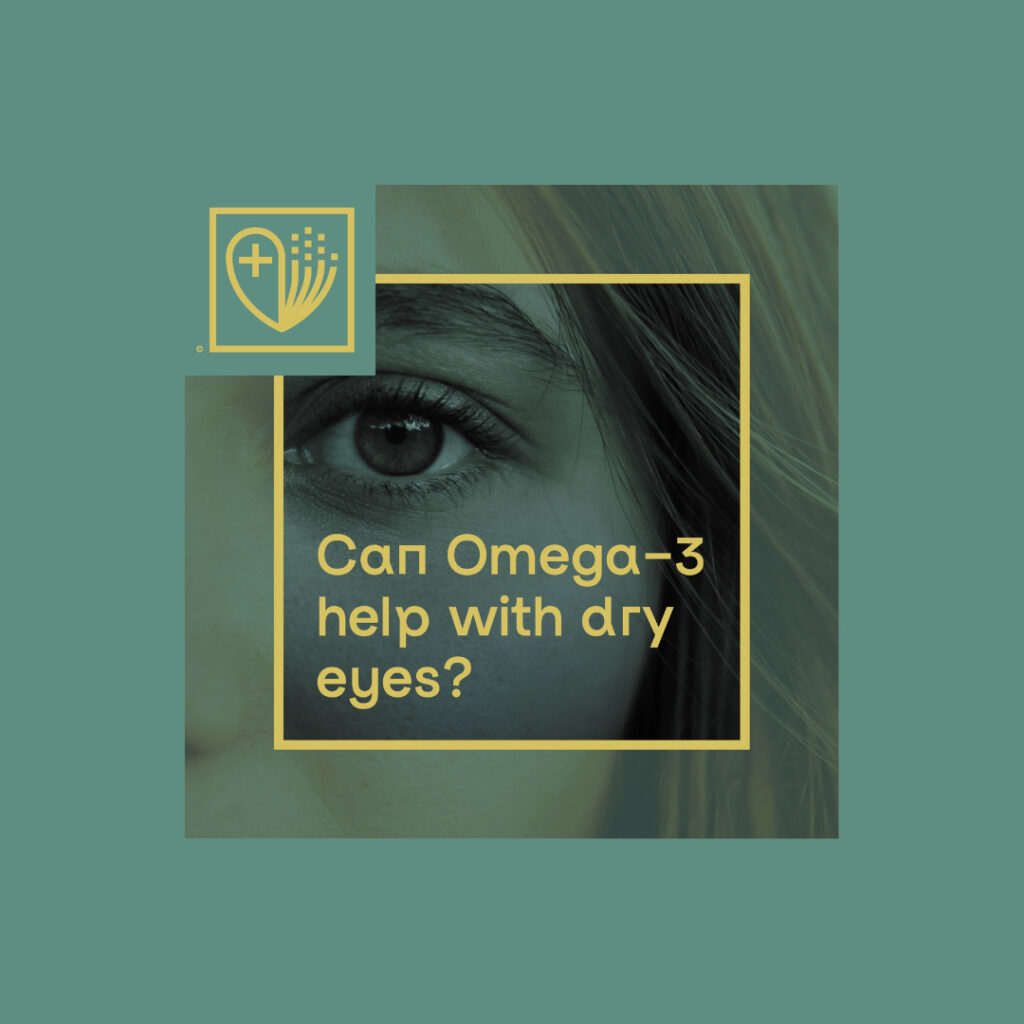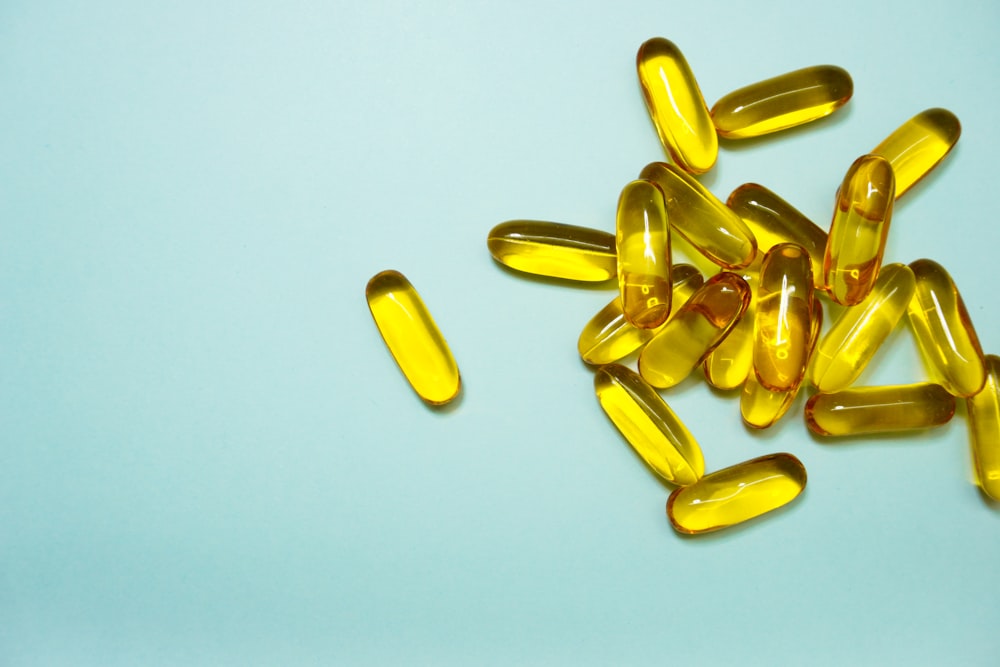Can Omega 3 help with dry eyes?
It is estimated that 25% of the Canadian population suffers from Dry Eye Disease (DED)[1], making it one of the most common eye problems seen by eye care professionals. Our eyes are full of tears. Tears provide moisture and lubrication to help us see and keep our eyes comfortable. Dry eyes can occur if you don’t have enough tears, or the tears lack the right balance of water, oil, and mucus to spread evenly without evaporating too fast. Sometimes, there’s an absence of equilibrium in your tear-flow system or air conditioner, heater, or other environmental condition could dry out our tear film.
There are also other causes of dry eyes such as:
- The natural aging process, particularly menopause or andropause
- Side effects of certain medicines for allergy
- Diseases that affect the ability to produce tears, like Sjogren’s syndrome, rheumatoid arthritis, and collagen vascular diseases
- Problems that don’t allow your eyelids to close the way they should such as bell’s palsy.
Studies on Omega-3 consumption and dry eyes
Many clinicians usually recommend the use of Omega-3 supplements to relieve symptoms. The Tear Film and Ocular Surface Society Dry Eye Workshop II (TFOS DEWS II) report also recommended dietary supplementation with omega-3 as the first stage of management for dry eye disease[2].
In addition, many new studies also revealed the positive relation between consuming omega-3 and the relief of dry eye symptoms.
One study published on Clinic Science journal assessed whether omega-3 fatty acid supplementation is more efficacious than placebo in amelioration of signs and symptoms of dry eye disease[3]. 17 randomized clinical trials involving 3363 participants who suffered from dry eye symptoms were included in the study. The research result provides evidence that omega-3 supplementation significantly improves dry eye symptoms in patients with dry eye disease when compared to the placebo group. The findings indicate that omega-3 supplementation may be an effective treatment for dry eye disease.
A newly published study conducted by the Centre for Ocular Research & Education (CORE) in February 2022, indicates that a novel combination of omega-3 and omega-6 fatty acids ingested as a dietary supplement significantly improves symptoms in people who suffer from severe dry eye disease[4]. Essential fatty acids are an established therapy, yet this is the first clinical trial to demonstrate the effect of eicosapentaenoic acid (EPA), docosahexaenoic acid (DHA), and γ-linoleic (GLA) acid in such a population.
This prospective, randomized, double-masked parallel-group study assessed the daily use of a supplement containing omega-3 and omega-6 fatty acids or the placebo (coconut and olive oil) for three months. Participants with daily use of a supplement containing omega-3 and omega-6 fatty acids demonstrated a substantial improvement in dry eye symptoms with the treatment at the study’s conclusion, averaging a 20.8-point reduction. That compared to a 7.8-point reduction in the similarly symptomatic placebo group. The findings suggest that even the most severe sufferers can benefit from a meaningful improvement in symptoms with omega-3 and -6 supplementation
Another common reason that is known to develop dry eyes is cataract surgery. The reason is that the surgery can disrupt the tear film, which lubricates the surface of the eyes. A recent prospective comparative cohort study in Korea examined the clinical outcomes of systemic re-esterified triglyceride (rTG) form omega-3 in patients with dry eye symptoms after cataract surgery. The specialists randomly give 32 of the 66 participants 2 tablets twice a day for 2 months of rTG form omega-3 supplement (containing a total of 1,680mg of EPA and 506mg DHA) along with artificial tears 4 times a day for the treatment of dry eye symptoms following uncomplicated cataract surgery. The remaining 34 participants in the control group only received artificial tears 4 times a day without omega-3 supplementation. At the 8-week mark, Omega 3 supplementation group showed a significant improvement compared with the control group[5].
One study also revealed that even short-term consumption of omega 3 can helps to reduce dry eye symptoms. This study demonstrated that oral consumption of omega-3 fatty acids (180 mg EPA and 120 mg DHA twice daily for 30 days) is associated with a decrease in the rate of tear evaporation, an improvement in dry eye symptoms, and an increase in tear secretion [6].
What are DHA and EPA and what is their purpose?
Studies on the effect of omega-3 on the dry eye are still ongoing. However, most researchers conclude that the Omega-3 fatty acids EPA and DHA have the most potent health benefits and are the most important in controlling the issues related to dry eyes. Specifically, a high EPA to DHA ratio may be most helpful for dry eyes.
EPA is an important anti-inflammatory long-chain polyunsaturated omega-3 fatty acid. EPA prevents the blood from clotting easily and has effects that might reduce pain and swelling. Our body uses EPA to produce signaling molecules called eicosanoids, which play numerous physiological roles and reduce inflammation. When there’s inflammation in our tear glands, cornea, or conjunctiva (outermost layers of eyes), our body may not make enough tears. Or tears won’t be made of the right equilibrium of water, oils, and salts. These changes make your eyes dry. EPA is especially efficient to cure dry eyes caused by inflammation and helps to balance the ingredients in the tear.
DHA is naturally concentrated in the retina of the eye and is known to ensure healthy retinal function. According to the National Center for Complementary and Integrative Health Trusted Source, DHA is important for the proper functioning of the brain and eyes. Some studies also showed that fortifying baby formula with DHA can improve the vision of infants[7]. DHA is a major lipid constituent of photoreceptor membranes and plays an essential role in sustaining their structural and functional integrity. Because the continuous renewal of retinal membranes needs a constant supply of omega-3 fatty acids, food, or supplements rich in DHA may help retinal function, especially where damage has already occurred by dry eyes.
List good sources of Omega 3
Fish and seafood
Most types of seafood contain small amounts of omega-3 fatty acids. However, fatty fish contain the most omega-3 fatty acids, especially cold-water fatty fish, such as salmon, mackerel, tuna, herring, and sardines. They are beneficial to relieve dry eye symptoms and are good sources of Omega 3 fatty acids.
Plant-based source
Omega-3 fatty acids are contained in a wide variety of plant foods. Sources include flaxseeds, chia seeds, hemp seeds, edamame, seaweed, etc. Most nuts appear to be generally healthy. For example, walnuts contain high amounts of omega 3. Almonds, macadamia nuts, hazelnuts, and pecans also appear to be good sources to replenish daily needs of Omega 3.
Seal oil
Seal Oil is a complete source of omega 3, including EPA, DHA, and DPA. DPA is an important part of omega-3 with proven benefits, and it is rich in seal oil. It promotes better absorption to optimize omega 3. Unlike fish oil, which contains a negligible amount of DPA, seal oil is easily absorbed by our body for maximum health benefits.

A diet rich in Omega 3 can help to preserve vision and relieve dry eye, however, consuming enough omega-3 fatty acids through food may be difficult due to the huge volume of food needed to achieve the optimal function in our body.
In this case, omega-3 supplements can be beneficial. But please remember that not all omega-3 fish oil supplements are created equal. As we can see from the studies listed above, omega-3 in the triglyceride form is the preferred choice for dry eyes[8]. Studies show that seal oil’s natural triglyceride (TG) form provides better absorption and assimilation. Seal oil seems to be the best option for people suffering from dry eyes.
Sources:
[1] https://mydryeye.ca/definition-diagnosis/
[2] Jones, L., Downie, L. E., Korb, D., Benitez-del-Castillo, J. M., Dana, R., Deng, S. X., … & Craig, J. P. (2017). TFOS DEWS II management and therapy report. The ocular surface, 15(3), 575-628.
[3] Giannaccare, G., Pellegrini, M., Sebastiani, S., Bernabei, F., Roda, M., Taroni, L., … & Campos, E. C. (2019). Efficacy of omega-3 fatty acid supplementation for treatment of dry eye disease: a meta-analysis of randomized clinical trials. Cornea, 38(5), 565-573.
[4] Ng, A., Woods, J., Jahn, T., Jones, L. W., & Ritter, J. S. (2022). Effect of a Novel Omega-3 and Omega-6 Fatty Acid Supplement on Dry Eye Disease: A 3-month Randomized Controlled Trial. Optometry and Vision Science, 99(1), 67-75.
[5] https://www.reviewofoptometry.com/article/dry-eye-where-do-we-stand-with-omega3-supplements
[6] Kangari, H., Eftekhari, M. H., Sardari, S., Hashemi, H., Salamzadeh, J., Ghassemi-Broumand, M., & Khabazkhoob, M. (2013). Short-term consumption of oral omega-3 and dry eye syndrome. Ophthalmology, 120(11), 2191-2196.
[7] Tai, E. K., Wang, X. B., & Chen, Z. Y. (2013). An update on adding docosahexaenoic acid (DHA) and arachidonic acid (AA) to baby formula. Food & function, 4(12), 1767-1775.
[8] https://stoneycreekeyecare.com/how-omega-3s-can-help-treat-dry-eye/






